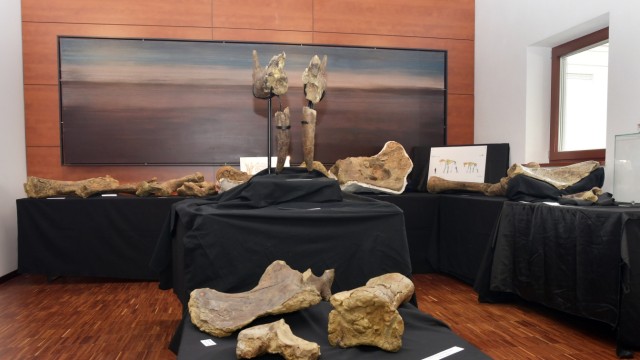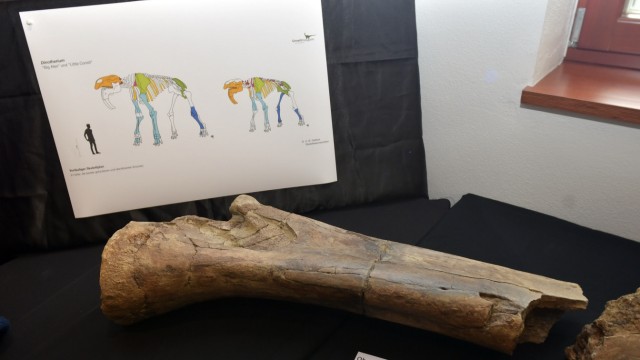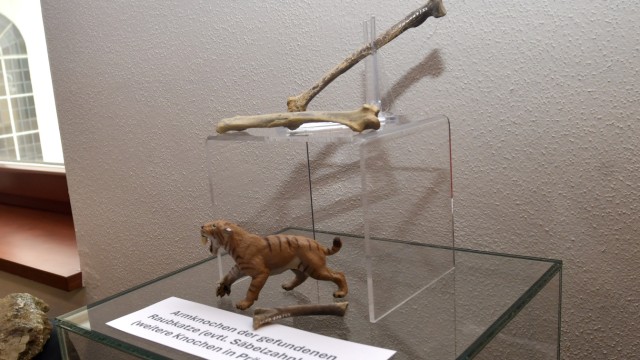An animal cemetery with the remains of three ancient elephants, skeletal and tooth remains of a big cat, an antelope and a large rhinoceros has been discovered in a small sand pit in Langenpreising near Erding. The elephants lived ten million years ago and stood up to 4.5 meters high at the shoulders. Today’s African elephants grow up to 3.50 meters tall. They are the largest land mammals that have ever lived in the region of what is now Germany.
Two skeletons are almost completely preserved, which is extremely rare. The majority of all finds so far consist only of bone fragments or individual molars. The sensational find was presented on Monday in Taufkirchen/Vils in the Erding district.
A fox and two schoolchildren played a key role in the discovery: in 2004, the Bavarian State Collection for Paleontology and Geology was able to accidentally recover a skull that belonged to one of the animals that had now been found. Since then, Peter Kapustin, volunteer director of the Prehistoric Museum in neighboring Taufkirchen, with the permission of the property owner, have been searching there for years. So far always in vain.
Peter Kapustin with his sons Constantin and Alexander (right) at the press conference.
(Photo: Renate Schmidt)
Then came April 13, 2023: His two sons Alexander (10) and Constantin (9) wanted to accompany Peter Kapustin. They ran off without him and came back with a strange roll of lime that the father identified as a coated ribeye. They had found it in a pile of sand in front of a fox hole. Together they searched the walls of the Burrow and saw a huge bone running across the entrance. Further excavation revealed further remains, some of them very large bones. The Bavarian State Collection and the Erding District Office were then informed.
The excavations began in the summer of 2023 and lasted months
The excavations required a lot of preparatory work; they began last summer and lasted several months. Among those involved were the geologists Alexander Benn and Hanna Loidl as well as the paleontological preparator Nils Knötschke. Geologist Benn identified the site as a former river bed in which the current was only very low. Otherwise the skulls and bones would have been damaged or even crushed by rubble and stones.
And they would have drifted much further. But in nine of the 200 square meters examined, am found two lower jaws, tusks, pelvises, upper jaws and ribs. More than 120 bones were found in the entire excavation area, including bones of a large cat, a saber-toothed cat, an antelope and the tooth of a rhinoceros. The excavation was measured using more than 1000 photos as photogrammetry and embedded in a 3D model.

First prepared finds, front lower legs and pelvis, from “Little Consti”.
(Photo: Renate Schmidt)

The site of the discovery, a fox hole, with the proud discoverer
(Photo: Renate Schmidt)

The size comparison clearly shows how big the elephants were back then
(Photo: Renate Schmidt)
It is not a classic elephant graveyard, as we know it today from adventure books or Hollywood films. The bones of African elephants are sometimes found in large numbers in swampy places because the animals lose their molars around the age of 60. The savanna grass then becomes too tough to bite and they migrate to swamplands where softer plant food grows. There they die of old age or sink into the swamp. This does not apply to these animals: Dinotherium gigantum or tusk elephants, as they are also called, lived in a tropical floodplain where they mainly fed on soft plant food.
Isotope studies of the animals’ tooth enamel have long since confirmed this. In addition, the two almost completely preserved elephants were young animals, which could be seen from the fact that not all of their teeth had yet erupted. Those involved in the excavation can only speculate about what may have led to her death. A natural event is obvious, possibly a flood or a lightning strike.

The arm bones of a big cat, believed to be a saber-toothed cat, are also part of the find.
(Photo: Renate Schmidt)
Perhaps the subsequent studies will provide even more information about the animals. So far, at least no bite marks have been found that could indicate scavengers. Instead, tree root impressions were found on the bones. Analyzes of the individuals will now be carried out to determine the age at which they died. And you want to look at the inside edge of the tank, from which you can conclude whether the animals were male or female. It is also intended to carry out a pollen analysis in order to determine the vegetation at that time more precisely.
Kapustin’s sons, the two young explorers, are honored with the naming: the larger specimen was called “Big Alex” and the smaller one “Little Conti”. The fox comes away empty-handed.

